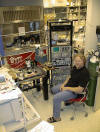This system allows intracellular recording from individual cells either with a sharp microelectrode or with a patch electrode. With the perforated patch technique we are currently using nystatin to gain access to the cell interior. Recordings examine membrane properties, action potential characteristics, measurements of conductance through current -voltage relationships (I-V), excitatory and inhibitory synaptic events. We are using these cellular techniques to study the effects of specific neurotransmitters and neuropeptides within the brainstem parabrachial nucleus, and the diagonal band of Broca (DBB), a forebrain nucleus.

DIC Slice patch recording
Single channel recording
We use electrophysiological patch clamp techniques to record isolated ion currents from acutely dissociated diagonal band of Broca (DBB) neurons and cultured basal forebrain neurons. Cell-attached and outside-out single-channel patch-clamp techniques are used in exploiting non-a7 nicotinic acetylcholine receptor (nAChR) functions. We are particularly interested in the mechanisms of nAChRs and interaction with beta amyloid, neurotransmitters, and drugs related to AD and neurodegeneration diseases. We quantitatively analyze single channel activity and combined with single-cell RT-PCR and Western blot techniques to identify the specified subtypes and mechanisms of nAChRs. Future work will use electrophysiology coupled with molecular biological approaches the nAChR ionic mechanisms and related signal transduction pathways.

Primary basal forebrain neuronal culture

Calcium imaging
Intracellular Ca2+ regulates and modulates many neuronal processes such as release of neurotransmitters, gene expression, and apoptotic pathways. Using our imaging system, we can examine how various drugs influence intracellular Ca2+ levels in neurons. In order to measure intracellular Ca2+, neurons are loaded with Fura-2, a Ca2+ sensitive fluorescent dye. We excite the intracellular Fura-2 with specific wavelengths of ultraviolet light emitted by a monochromater. The intensity of the fluorescence emitted by Fura-2 is measured with a digital camera and used to calculate the intracellular Ca2+ concentration.

